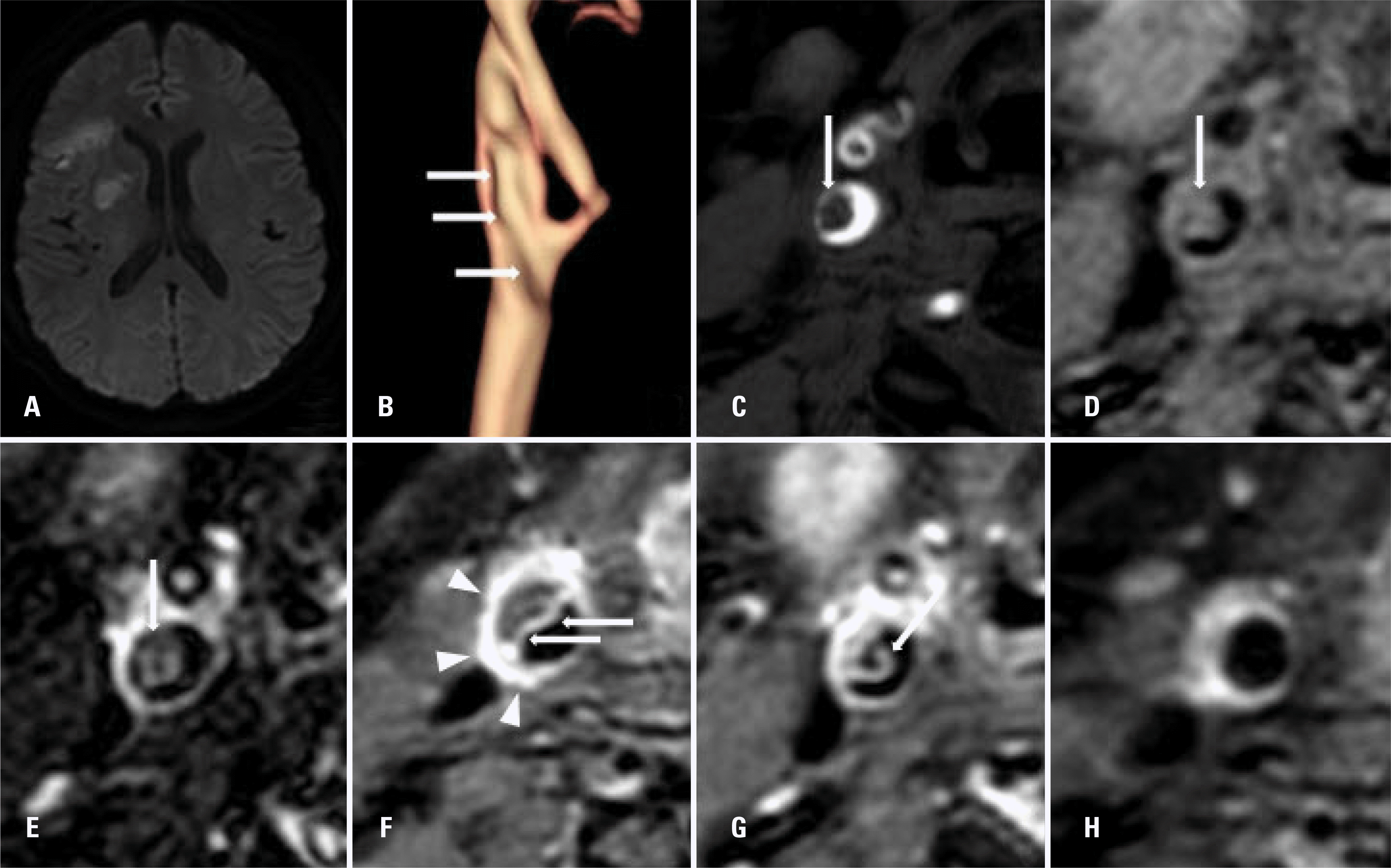초록
Carotidynia is characterized by unilateral neck pain around the carotid artery. We describe a 50-year-old woman who presented with transient left-side weakness and right-side neck pain. She frequently massaged the uncomfortable neck area during the symptomatic course of the condition. Magnetic resonance imaging revealed multifocal cerebral infarctions and a carotid intramural thrombus ipsilateral to the carotidynia.Long-term carotidynia might result in the involvement of an intramural thrombus and intimal disruption, and ischemic stroke after carotidynia may be provoked by carotid sinus massage.
REFERENCES
1.Spiller WG. Philandelphia Neurological Society: regular meeting, Jan. 28, 1927. Arch Neurol Psychiatry. 1927. 18:308.
2.Upton PD., Smith JG., Charnock DR. Histologic confirmation of carotidynia. Otolaryngol Head Neck Surg. 2003. 129:443–444.

3.Schaumberg J., Eckert B., Michels P. Carotidynia: magnetic resonance imaging and ultrasonographic imaging of a self-limiting disease. Clin Neuroradiol. 2011. 21:91–94.
4.Burton BS., Syms MJ., Petermann GW., Burgess LP. MR imaging of patients with carotidynia. AJNR Am J Neuroradiol. 2000. 21:766–769.
5.Matsubara H., Takeshita K., Nakamura S., Murohara T., Miyachi S. Carotidynia with carotid arterial thrombosis. Ann Intern Med. 2012. 157:917–919.

6.Woo JK., Jhamb A., Heran MK., Hurley M., Graeb D. Resolution of existing intimal plaque in a patient with carotidynia. AJNR Am J Neuroradiol. 2008. 29:732–733.

7.Kuhn J., Harzheim A., Horz R., Bewermeyer H. MRI and ultrasonographic imaging of a patient with carotidynia. Cephalalgia. 2006. 26:483–485.

8.Paling D., Vilches-Moraga A., Akram Q., Atkinson O., Staniland J., Paredes-Galán E. Carotid sinus syndrome is common in very elderly patients undergoing tilt table testing and carotid sinus massage because of syncope or unexplained falls. Aging Clin Exp Res. 2011. 23:304–308.

9.Currò DR., Roscia G., Turri E., Dall'Ora E., Sansone S., Stockner I, et al. Acute ischemic stroke complicating carotid sinus massage in the absence of carotid artery disease and failure of thrombolytic therapy. Minerva Med. 2010. 101:193.
Fig. 1.
A 50-year-old woman with a transient left-side weakness and mild dysarthria. (A) Diffusion-weighted imaging showing multifocal infarctions in the right basal ganglia, frontal cortex, and parietal cortex. (B) Volume-rendering imaging showing a filling defect in the long segment of the CCA and ICA (arrows). (C) Axial source image of time-of-flight carotid MRA showing a massive intraluminal filling defect in the right CCA (arrow). (D) Axial image of nonenhanced T1-weighted carotid MRI showing the intravascular thrombus without an intramural plaque or intimal flap (arrow). (E) Axial image of nonenhanced T2-weighted carotid MRI showing the intravascular thrombus without an intramural plaque or intimal flap (arrow). (F) Contrast-en-hanced MRI of the right CCA showing the circumferential enhancement (arrowheads) with a mural wall thrombus (arrows). (G) Contrast-enhanced MRI of the right ICA showing the intimal disruption (arrow). (H) Contrast-enhanced axial imaging performed 10 days after the initial carotid plaque MRI showing complete resolution of the mural wall thrombus and intimal disruption and a marked decrease in the circumferential carotid wall enhancement. CCA, common carotid artery; ICA, internal carotid artery; MRA, magnetic resonance angiography; MRI, magnetic resonance imaging.





 PDF
PDF ePub
ePub Citation
Citation Print
Print


 XML Download
XML Download